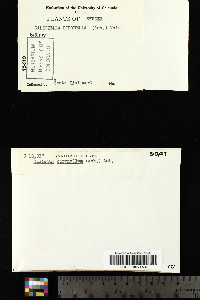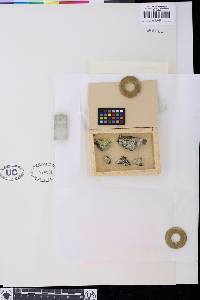
Consortium of Lichen Herbaria
- building a Global Consortium of Bryophytes and Lichens as keystones of cryptobiotic communities -
- Home
- Search
- Images
- Species Checklists
- US States: O-Z >
- US National Parks
- Central America
- South America
- US National Parks
- Southern Subpolar Region
|
|
|
|
Family: Caliciaceae
[Caliciella corynella (Ach.) Vain., moreCaliciella corynella var. corynella (Ach.) Vain., Caliciella corynella var. subsessile Vain., Calicium corynellum var. subsessile (Vain.) Zahlbr., Lichen corynellus Ach.] |
Nash, T.H., Ryan, B.D., Gries, C., Bungartz, F., (eds.) 2004. Lichen Flora of the Greater Sonoran Desert Region. Vol 2. Life habit: lichenized Thallus: often well developed, fairly thick, farinose-granular, sorediose, yellowish green or green Apothecia: sessile or short-stalked, (0.2-)0.50.6(-1.2) mm high, 3-5 times as high as width of central part of stalk, black; stalk: dull, 0.07-0.13 mm in diam., consisting of dark brown, moderately sclerotized, thick-walled, intricately interwoven hyphae 2-3 µm diam. capitulum: up to 0.4 mm in diam., in sessile fruits, lenticular, dull, with faint gray-white pruina on lower side of exciple exciple: dark brown, 40-75 µm thick, consisting of largely anticlinally arranged, strongly sclerotized, intertwined cells; hypothecium: medium brown, with flat upper surface, consisting of clearly discernible, intertwined hyphae 2-2.5 µm in diam. asci: clavate, 21-27 x 4.5-5.5 µm, with 2-3-seriately arranged spores ascospores: narrowly ellipsoid, 12-14(-16) x 4-6 µm, constricted at the septum, with spirally arranged ridges when young, later becoming cracked Spot tests: thallus K-, C-, KC-, P-; all parts of apothecia I- Secondary metabolites: thallus with rhizocarpic and usnic acids. Substrate and ecology: on siliceous rocks, on steep surfaces and under overhangs in very humid habitats World distribution: Europe and North America Sonoran distribution: Arizona. Notes: Calicium corynellum is characterized by its rather short-stalked and slightly pruinose ascomata, its greenish to yellowish thallus, the clavate asci and rather, coarsely ornamented spores. Calicium corynellum differs from C. viride in having much shorter ascomata, a leprose rather than verrucose thallus and a grayish white pruina. See Ti-bell (1999a) for fuller description. |
Powered by Symbiota















































